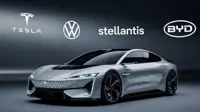Global smartphone sales growth declines to 3.7 per cent in 4Q2008
12 Mar 2009
Mumbai: In the fourth quarter of 2008, worldwide sales of smartphones to end users reached 38.1 million units, an increase of 3.7 per cent on the fourth quarter of 2007, according to Gartner, Inc. Global sales of smartphones for 2008 reached 139.3 million devices, up 13.9 per cent compared with 2007.
''After a strong third quarter with new product introductions, sequential growth slowed down again in the fourth quarter as fewer compelling new products and the worsened economic climate continued to make data plans associated with smartphones out of reach for most consumers,'' said Roberta Cozza, research director at Gartner.
Cozza said, ''In general in 2008, the focus from vendors and operators on increasing their smartphone portfolios remained very strong. Samsung, RIM, HTC and Apple saw their volumes and share increase during 2008 (see Table 2), thanks to their ability to offer compelling device experiences and touch interfaces.''
As a proportion of all mobile device sales, smartphones remained stable at 12 per cent in the fourth quarter of 2008, from 11 per cent in the fourth quarter of 2007. Samsung entered the top five vendors ranking for the first time (see Table 1), replacing Sharp. RIM recorded an increase in sales both sequentially and year-over-year, while Nokia's volumes continued to fall.
Worldwide: Smartphone Sales to End Users by Vendor, 4Q08 (Thousands of Units)
| Company | 4Q08 Sales | Market Share 4Q08 (%) | 4Q07 Sales | Market Share 4Q07 (%) | 4Q07-4Q08 Growth (%) |
| Nokia | 15,561.7 | 40.8 | 18,703.3 | 50.9 | -16.8 |
| Research In Motion | 7,442.6 | 19.5 | 4,024.7 | 10.9 | 84.9 |
| Apple | 4,079.4 | 10.7 | 1,928.3 | 5.2 | 111.6 |
| HTC | 1,631.7 | 4.3 | 1,361.1 | 3.7 | 19.9 |
| Samsung | 1,598.2 | 4.2 | 671.5 | 1.8 | 138.0 |
| Others | 7,829.7 | 20.5 | 10,077.3 | 27.4 | -22.3 |
| Total | 38,143.3 | 100.0 | 36,766.1 | 100.0 | 3.7 |
Nokia maintained its No 1 position, but in the fourth quarter of 2008 its smartphone sales declined by 16.8 per cent year-on-year. This also contributed to the overall weakness of the global smartphone segment in 4Q08, as the company commanded 40.8 per cent of the market. Nokia's entry-level smartphone range will continue to offer good value for the money, but Nokia remains more exposed to pressure from competition in the higher end of the consumer smartphone market as the Nseries loses its appeal.
Apple's initial sell-through dropped significantly as sales fell during the fourth quarter. Nevertheless, Apple maintained its third position in the global rankings. Apple built an inventory of about two million iPhone units in the third quarter of 2008 which did not reduce significantly in the fourth quarter. With Apple's sequential decline, volumes were driven by new product introductions such as the RIM Storm, the T-Mobile G1 (the first product based on Google's Android platform), and strong performance from Samsung's touchscreen products. HTC had a very strong quarter with record sales of its HTC-branded devices and operator-branded devices.
Worldwide: Smartphone Sales to End Users by Vendor, 2008 (Thousands of Units)
| Company | 2008 Sales | Market Share2008 (%) | 2007 Sales | Market Share 2007 (%) | Growth 2007-2008 (%) |
| Nokia | 60,920.5 | 43.7 | 60,465.0 | 49.4 | 0.8 |
| Research In Motion | 23,149.0 | 16.6 | 11,767.7 | 9.6 | 96.7 |
| Apple | 11,417.5 | 8.2 | 3,302.6 | 2.7 | 245.7 |
| HTC | 5,895.4 | 4.2 | 3,718.5 | 3.0 | 58.5 |
| Sharp | 5,234.2 | 3.8 | 6,885.3 | 5.6 | -24.0 |
| Others | 32,671.4 | 23.5 | 36,176.6 | 29.6 | -9.7 |
| Total | 139,287.9 | 100.0 | 122,315.6 | 100.0 | 13.9 |
In the smartphone operating system (OS) market, Symbian's share of the global market decreased to 47.1 per cent in the fourth quarter of 2008, down from its 2007 share of 62.3 per cent (see Table 3). Pressure from new platforms entering the consumer space, the continued decline of Nokia's smartphone sales and the weakness of the Japanese mobile device market have negatively affected Symbian's share. Meanwhile, RIM successfully grew its year-on-year share of the global smartphone market to 19.5 per cent from 10.9 per cent. Gartner estimated that Android smartphones accounted for 20 per cent of total Linux sales in the fourth quarter of 2008.
In the fourth quarter of 2008, Microsoft's share of the global smartphone market improved sequentially, with unit sales up 16 per cent over 3Q08. This was mainly driven by the popularity of Samsung Omnia and touchscreen products from HTC. Sales of Linux-based smartphones were up by 19 per cent year-over-year, mainly through Android-based smartphones being available through T-Mobile during the fourth quarter of 2008.
Worldwide: Smartphone Sales to End Users by Operating System, 4Q08 (Thousands of Units)
| Company | 4Q08 Sales | Market Share 4Q08 (%) | 4Q07 Sales | Market Share 4Q07 (%) | Growth 4Q07-4Q08 (%) |
| Symbian | 17,949.1 | 47.1 | 22,902.5 | 62.3 | -21.6 |
| Research In Motion | 7,442.6 | 19.5 | 4,024.7 | 10.9 | 84.9 |
| Microsoft Windows Mobile | 4,713.9 | 12.4 | 4,374.4 | 11.9 | 7.8 |
| Mac OS X | 4,079.4 | 10.7 | 1,928.3 | 5.2 | 111.6 |
| Linux | 3,194.9 | 8.4 | 2,675.9 | 7.3 | 19.4 |
| Palm OS | 326.5 | 0.9 | 449.1 | 1.2 | -27.3 |
| Other OSs | 436.9 | 1.1 | 411.3 | 1.1 | 6.2 |
| Total | 38,143.3 | 100.0 | 36,766.1 | 100.0 | 3.7 |
Worldwide: Smartphone Sales to End Users by Operating System, 2008 (Thousands of Units)
| Company | 2008 Sales | Market Share 2008 (%) | 2007 Sales | Market Share 2007 (%) | Growth 2007-2008 (%) |
| Symbian | 72,933.5 | 52.4 | 77,684.0 | 63.5 | -6.1 |
| Research In Motion | 23,149.0 | 16.6 | 11,767.7 | 9.6 | 96.7 |
| Microsoft Windows Mobile | 16,498.1 | 11.8 | 14,698.0 | 12.0 | 12.2 |
| Mac OS X | 11,417.5 | 8.2 | 3,302.6 | 2.7 | 245.7 |
| Linux | 11,262.9 | 8.1 | 11,756.7 | 9.6 | -4.2 |
| Palm OS | 2,507.2 | 1.8 | 1,762.7 | 1.4 | 42.2 |
| Other OSs | 1,519.7 | 1.1 | 1,344.0 | 1.1 | 13.1 |
| Total | 139,287.9 | 100.0 | 122,315.6 | 100.0 | 13.9 |
Note: The "Other OSs" category includes sales of Sharp Sidekick devices based on the Danger platform. Source: Gartner (March 2009)
On a regional level, the North American smartphone market continued to grow, despite the larger economic problems. Smartphones account for roughly 20 per cent of sales in this region, a dramatic increase over the past year. Smartphone sales in North America grew 69 per cent in 2008.
While sales will grow at a slower pace, the market will be driven by support from operators in the region aggressively pushing data plans. Smartphones will also see increased competition from full-featured enhanced phones that may offer a full qwerty keyboard. These devices offer much of the functionality of a smartphone, but at a lower price.
Smartphone sales in Asia/Pacific recorded a 2.3 per cent sequential growth, reaching 7.5 million unit sales, even though overall mobile device sales dropped by 9.2 per cent. The drop in overall sales was attributable to weak consumer confidence, but sales of high-end devices remained good, leading to positive sequential growth for smartphones. Market leader Nokia lost market share marginally by 2 per cent to Apple. Others that gained in the region were RIM and Samsung. Touch-based devices continued to attract consumers in this segment.
Smartphone sales in Europe, the Middle East and Africa (EMEA) were up by only 2 per cent in 4Q08 compared with the same period last year. Despite replacement purchases slowing down in Western Europe, smartphone sales still recorded a 9.6 per cent increase in the region. Samsung was the main contributor to the growth in Europe thanks to the success of its Omnia touchscreen smartphone. Samsung's share nearly tripled during the fourth quarter of 2008 and the strong push of its touchscreen offerings in EMEA put pressure on HTC.
Ms Cozza concluded: ''In 2009, mobile platforms will be a major battleground as the associated user experience and role of the ecosystem grow in importance.''







.webp)














